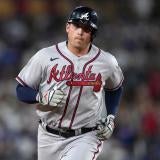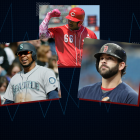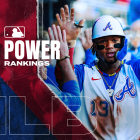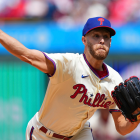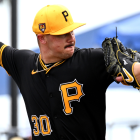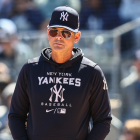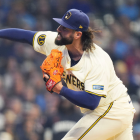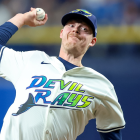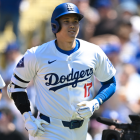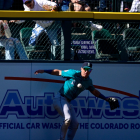In less than two weeks MLB will hold its annual amateur draft, and once that passes, front offices across baseball will turn their attention to the trade deadline. The trade deadline often has an impact on the free-agent market. Traded players can not receive the qualifying offer, for starters, and there's always a chance a rental player signs an extension.
For now, extension season has come to an end, so the 2019-20 free-agent class has not lost any marquee players to long-term deals in the past few weeks. As we've been doing all season, we're going to check in on the upcoming free-agent class with weekly stock watch posts, and also rank impending free agents every month. Here is this week's stock watch.
Stock Up
Edwin Encarnacion was dealt a crummy hand this year. After playing in the postseason every year from 2015-18, the Indians sent Encarnacion to the Mariners in a salary-shuffle trade over this winter. His chances of playing in October for a fifth consecutive year went down significantly with the deal.
That's the business though, and rather than sulk, Encarnacion has put together a bounce-back season at the plate. He owns a .254/.368/.514 batting line that is 50 percent better than league average when adjusted for ballpark. Encarnacion had been trending in the wrong direction the last few years:
- 2014: 152 OPS+
- 2015: 148 OPS+
- 2016: 134 OPS+
- 2017: 128 OPS+
- 2018: 115 OPS+
Encarnacion, who sports a career 11.2 percent walk rate, has always been a patient hitter. Encarnacion has chopped his chase rate down to 24.0 percent his year, well below the 29.9 percent league average and in line with his 2013-17 rate. A spike in chase rate can be an indication of a slowing bat -- veteran hitters have to cheat a bit to catch up to fastballs and that leaves them more susceptible to breaking balls -- and that looked to be the case with Encarnacion last year. That isn't the case now.
I am certain the Mariners would trade Encarnacion and as much of the $19 million remaining on his contract tomorrow if it were possible. Given his production and veteran savvy, there could be a market for him at the trade deadline. The Yankees could have interest if their injuries persist, for example. A strong finish with a contending team will only help Encarnacion's stock heading into the winter.
That said, Encarnacion will be 37 on Opening Day next year and he is limited defensively, which will hurt his market. These days teams are steering clear of the veteran DH masher. Encarnacion is not most veteran DH mashers though. His track record is as good as it gets and he has a reputation for being a great teammate. Plus he's having a strong free-agent year.
Encarnacion is undoubtedly looking at a small base salary one-year contract after the season. Maybe $7 million or so. I believe Encarnacion will have an easier time finding work this winter than most players his age and at his position though. There's still enough thump in his bat to entice contenders looking for an affordable middle of the order hitter.
What an unusual season for Mitch Moreland. The Red Sox first baseman has 13 home runs this year, two fewer than last year in 293 fewer plate appearances. He also seems to be hitting only home runs. Moreland has 11 singles and a .214 batting average on balls in play. Hooray for easy season sample season weirdness!
Except it's not that early anymore. The season is roughly one-third complete. Moreland has traded some line drives for fly balls this year ...
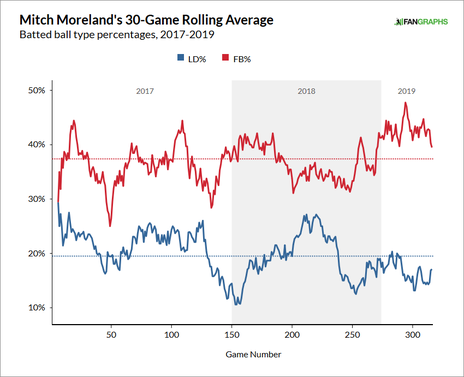
... and fly balls go for outs more than often than line drives. That at least partially explains the low batting average on balls in play. Routine fly balls are fairly easy outs. That said, the important thing is Moreland is getting the ball in the air often, and his exit velocity is up quite a bit this year. Some numbers:
- Exit velocity: 93.1 mph (87.4 mph career average)
- Hard-hit rate: 54.2 percent (34.2 percent career average)
Moreland's exit velocity is in the top four percent of the league. His hard-hit rate is in the top three percent. Statcast calculates his expected slugging percentage (based on exit velocity, launch angle, etc.) at .568. His actual slugging percentage is .573. Moreland is hammering the ball and being rewarded appropriately.
The low batting average is an eyesore more than a deal breaker, especially since Moreland is taking walks as always (12.7 percent), hitting for big power, and playing his typically nifty first-base defense. Even with 34th birthday coming up in September, Moreland has a chance for another two-year contract, which is more than you can say for most first basemen that age. Two years and $6 million per year is perfectly reasonable, even in this free-agent climate.
Stock Down
Despite having the division's second-best run differential (plus-25), the Reds are five games under .500 and sitting in last place in the NL Central. Things are not going according to plan in Cincinnati and that goes double for Yasiel Puig, the biggest name acquired in the team's winter trade spree.
Pug is currently sitting on a .206/.253/.358 batting line with seven homers this season, and many of his underlying rate stats are career worsts, or approaching career worsts. To wit:
| 2019 | Previous career worst | |
|---|---|---|
Strikeout rate | 25.3% | 22.5% (2013) |
Walk rate | 5.6% | 6.5% (2016) |
Swing-and-miss rate | 15.6% | 17.0% (2013) |
Chase rate | 36.8% | 37.2% (2013) |
Puig's expected weighted on-base average, which Statcast calculates based on exit velocity and launch angle and things like that, sits at .309, which is in the 31st percentile. He is not making good contact and the results show. For all intents and purposes, this is the worst version of Puig we've seen. He's been far too undisciplined.
I suspect there is also a human element to Puig's struggles this year. Much was made of being reunited with hitting coach Turner Ward, who was with the Dodgers from 2016-18, but Puig also changed teams and divisions in a walk year. It's not easy. It's not an excuse, guys change teams every year, but it's not easy. I wouldn't be surprised if Puig's still adjusting to his new situation.
The good news? Puig turns only 29 in December and there is a lot -- a lot -- of season to be played, and he is awfully talented. Things could click tomorrow and he could put up big numbers (in a hitter-friendly home ballpark) the rest of the season, and set himself up for a big free-agent payday. Right now though, Puig's walk year is going about as poorly as expected.
It is easy to come up with reasons to criticize Puig and, fairly or unfairly, I suspect he will be one of the most scrutinized free agents on the market this winter. Every negative will be highlighted and the positives won't get as much attention. When right though, Puig is a true impact player, and he is right smack in the prime of his career. He has a lot to offer.
Depending how the rest of the season plays out, Puig could be looking at anything from a one-year "prove yourself" contract -- I could totally see such a deal working out like Adrian Beltre's 2010 season with the Red Sox -- to a sizable multiyear guarantee, perhaps four years at $15 million per season. It's not too late for Puig to turn his season around, but it has to happen soon.
Even Ivan Nova's good starts have been laborious this season. Wednesday night the veteran right-hander held the high-powered Astros to three runs in seven innings, though he also allowed 10 hits, got helped out by a triple play, and did not have a single 1-2-3 inning. The highest ERAs in baseball (min. 50 innings):
- Ivan Nova, White Sox: 6.96
- Jorge Lopez, Royals: 6.04
- Kyle Freeland, Rockies: 6.02
- Jake Junis, Royals: 5.69
- Michael Pineda, Twins: 5.43
There is much more to life than ERA, of course, but Nova's underlying numbers are just as bad. His 14.1 percent strikeout rate is second-lowest in baseball, his expected batting average is in the bottom six percent in the league at .308, and his velocity has dipped across the board. Nova is a sinkerballer whose ground ball rate has dipped noticeably:
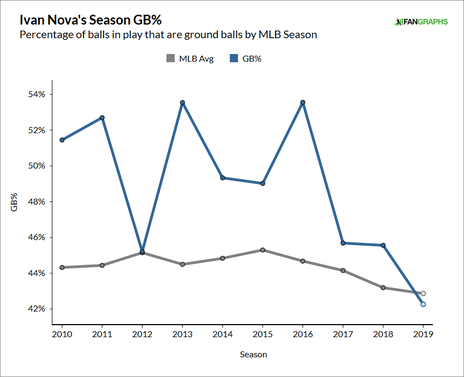
In the launch angle era, a sinkerballer who can't get ground balls is like the goat in the T-Rex paddock in Jurassic Park. There is only a small chance of survival. Nova's stuff is slipping at age 32 -- a perfectly normally baseball thing, that is -- and he didn't have the biggest margin of error to start with. There is some bad luck behind that 6.96 ERA, but it is mostly deserved.
Pitching will forever be in demand so I doubt Nova is headed for a forced retirement as a free agent. His contract upside might only be something along the lines of Matt Moore's contract with the Tigers (one year and $2.5 million). At this rate, Nova might even have to settle for a minor league contract and compete for a fifth starter/longman role in spring training.

















